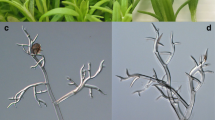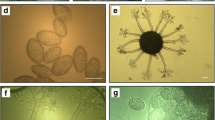Abstract
Zinnia, blue torenia, dahurian patrinia, and scoparia were found to be affected by powdery mildews from 2006 to 2008 in Tokyo. Abundant white, powdery colonies were observed to grow on the stems and leaves of each plant species resulting in chlorosis and eventual dieback of infected leaves and stems. Based on the morphological characteristics of the strain from each plant species, the causal agents were determined to belong to the genus Euoidium and pathogenicity to each original host was confirmed through inoculation experiments. This is the first report of Euoidium infection on these four plant species in Japan.





Similar content being viewed by others
References
Amano (Hirata) K (1986) Host range and geographical distribution of the powdery mildew fungi. Japan Societies Press, Tokyo
Anonymous (2012) Common names of plant diseases in Japan, 2nd edn (in Japanese). Phytopathological society of Japan and national institute of agrobiological sciences, Tokyo, pp 275–277, 1344–1345, 1492
Bhagyanarayana G, Ramachar P (1983) Nomenclatural changes in the genus Oidium. Curr Sci 52:170–171
Braun U, Cook RTA (2012) Taxonomic manual of the Erysiphales (powdery mildews), CBS Biodiversity Series 11: CBS, Utrecht
Hirata K (1942) On the shape of germ tubes of Erysiphaceae (in Japanese with English summary). Bull Chiba Coll Hort 5:34–49
Hirata K (1955) On the shape of germ tubes of Erysiphaceae II (in Japanese with English summary). Bull Fac Agric Niigata Univ 7:24–36
Makino T (1996) Revised Makino’s illustrated flora in color (in Japanese). Hokuryukan, Tokyo, pp 188–218
Murata G (1994) The grand dictionary of horticulture (in Japanese). Shogakukan, Tokyo, pp 890–891
Nomura Y (1997) Taxonomical study of Erysiphaceae of Japan (in Japanese with English summary). Yokendo, Tokyo, pp 223–229
Oba H (1997) The world of plants (in Japanese), vol 2. Asahi Shinbun Publication, Tokyo, pp 83–84
Sharma ND, Jain AC (1975) A new species of Acrosporium Nees ex Gary with a note on Oidium pedilanthi Mathur et al. Curr Sci 44:607–608
Shin HD (2000) Erysiphaceae of Korea. Nat Inst Agric Sci Tech, Suwon, pp 73–89
Vági P, Kovács GM, Kiss L (2007) Host range expansion in a powdery mildew fungus (Golovinomyces sp.) infecting Arabidopsis thaliana: Torenia fournieri as a new host. Eur J Plant Pathol 117:89–93
Yamazaki T (1982) Wild flowers of Japan (Herbaceous plants) III (in Japanese). Heibonsha Publishers, Tokyo, pp 97–121
Acknowledgments
This work was supported in part by a Grant-in-Aid for Scientific Research (C) (No. 18580046) from the Ministry of Education, Science, Sports and Culture of Japan.
Author information
Authors and Affiliations
Corresponding author
Rights and permissions
About this article
Cite this article
Hoshi, H., Sato, Y., Kagiwada, S. et al. First report of powdery mildew on zinnia, blue torenia, dahurian patrinia and scoparia caused by genus Euoidium in Japan. J Gen Plant Pathol 79, 89–95 (2013). https://doi.org/10.1007/s10327-012-0425-3
Received:
Accepted:
Published:
Issue Date:
DOI: https://doi.org/10.1007/s10327-012-0425-3




